Carrier sense adaptive transmission (CSAT) in unlicensed spectrum
a carrier sense and adaptive transmission technology, applied in the field of telecommunications, can solve the problems of poor user experience, encroachment on the operation of other parties, and cannot fully accommodate channel characteristics, so as to and reduce the interference between rats
- Summary
- Abstract
- Description
- Claims
- Application Information
AI Technical Summary
Benefits of technology
Problems solved by technology
Method used
Image
Examples
Embodiment Construction
[0040]The present disclosure relates generally to Carrier Sense Adaptive Transmission (CSAT) communication and various related aspects to reduce interference between co-existing Radio Access Technologies (RATs). The parameters for a given CSAT communication scheme may be adapted dynamically based on received signals for a native RAT to be protected and an identification of how that RAT is utilizing a shared resource such as an unlicensed band. To better associate received signaling with the native RAT and distinguish it from other RAT signaling as well as noise, a particular transceiver operating in accordance with the native RAT may be used to receive the signals (rather than a transceiver operating in accordance with another RAT that scans for aggregate background signal strength). For example, for a shared Wi-Fi medium, a co-located Wi-Fi radio may sniff the medium for Wi-Fi packets. Wi-Fi packets may be detected by decoding one or more Wi-Fi signatures and utilization of the Wi-...
PUM
 Login to View More
Login to View More Abstract
Description
Claims
Application Information
 Login to View More
Login to View More - R&D
- Intellectual Property
- Life Sciences
- Materials
- Tech Scout
- Unparalleled Data Quality
- Higher Quality Content
- 60% Fewer Hallucinations
Browse by: Latest US Patents, China's latest patents, Technical Efficacy Thesaurus, Application Domain, Technology Topic, Popular Technical Reports.
© 2025 PatSnap. All rights reserved.Legal|Privacy policy|Modern Slavery Act Transparency Statement|Sitemap|About US| Contact US: help@patsnap.com



